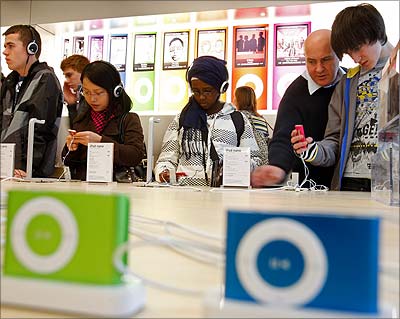
President Barack Obama was sworn into office this week as our nation’s 44th president. Despite running into a few technical challenges in the first few days at the White House, the Obama Administration will embrace technology in unprecedented ways. Led by forward thinking, web savvy technologists
in the first few days at the White House, the Obama Administration will embrace technology in unprecedented ways. Led by forward thinking, web savvy technologists , President Obama’s new media team looks poised and ready to fulfill President Obama’s vision of open-source democracy.
, President Obama’s new media team looks poised and ready to fulfill President Obama’s vision of open-source democracy.
Coincident with Mr. Obama being sworn in, the Obama Administration’s new media team assumed control of WhiteHouse.gov at 12:01 PM EST on Tuesday. This is the official website of the sitting administration. The new media team has identified three top priorities of the new administration – communication, transparency and participation. Let’s examine how the new administration has been leveraging web technologies to meet these priorities.
– communication, transparency and participation. Let’s examine how the new administration has been leveraging web technologies to meet these priorities.
Communication. This administration’s use of Google’s YouTube during both the campaign and after winning the election leverages Internet video to reach a generation of Americans and global citizens who no longer tune in to AM radio on a regular basis. President Obama has vowed to continue video recording his fireside chats and publishing them via YouTube and other video sites. With the transition of WhiteHouse.gov to the new administration, for the first time ever an official White House blog came online. You can sign up for email updates from the president. Through the blog, Mr. Obama is the first U.S. president to have an RSS feed!
during both the campaign and after winning the election leverages Internet video to reach a generation of Americans and global citizens who no longer tune in to AM radio on a regular basis. President Obama has vowed to continue video recording his fireside chats and publishing them via YouTube and other video sites. With the transition of WhiteHouse.gov to the new administration, for the first time ever an official White House blog came online. You can sign up for email updates from the president. Through the blog, Mr. Obama is the first U.S. president to have an RSS feed!
During the campaign President Obama relied heavily on Facebook , Myspace
, Myspace and Twitter
and Twitter to build support, communicate with constituents and develop a core audience. By far, Mr. Obama has more followers on Twitter
to build support, communicate with constituents and develop a core audience. By far, Mr. Obama has more followers on Twitter than anyone else (168,000). His fan page on Facebook has more than 4 million fans.
than anyone else (168,000). His fan page on Facebook has more than 4 million fans.
Transparency. Mr. Obama promises to run the most open, honest and transparent administration to date. Through the Your Seat at The Table section on the CHANGE.GOV
section on the CHANGE.GOV transition site, the Obama transition team posted the minutes of hundreds of private meetings with then President-Elect Obama.
transition site, the Obama transition team posted the minutes of hundreds of private meetings with then President-Elect Obama.
Even all of the content on the CHANGE.GOV site, unless otherwise noted, is licensed to the public at large via a Creative Commons Attribution 3.0 License .
.
The Obama-Biden Transition Team used my company, blist, to disclose the names of all donors
to disclose the names of all donors to the transition project. Two key points of note are that the disclosure was entirely voluntary and the tool they chose to use made the data itself much more consumable by the mainstream public. Compared to a plain HTML table, which is bulky, cumbersome and hard to work with, by publishing the data via a blist widget
to the transition project. Two key points of note are that the disclosure was entirely voluntary and the tool they chose to use made the data itself much more consumable by the mainstream public. Compared to a plain HTML table, which is bulky, cumbersome and hard to work with, by publishing the data via a blist widget the data can easily be sorted, searched, filtered, downloaded, printed, emailed and even republished – all capabilities not previously enjoyed by most consumers of public data sets.
the data can easily be sorted, searched, filtered, downloaded, printed, emailed and even republished – all capabilities not previously enjoyed by most consumers of public data sets.
Participation. The Obama Administration has been conducting bold experiments in interactive government. The Citizen’s Briefing Book , powered by Salesforce.com
, powered by Salesforce.com , has allowed citizens to suggest topics Mr. Obama should consider upon taking office. Once a topic was submitted, other visitors to the Citizen’s Briefing Book could vote the topic up or down and comment on it. Voting, ranking and commenting are hallmark features of web-based, social media applications.
, has allowed citizens to suggest topics Mr. Obama should consider upon taking office. Once a topic was submitted, other visitors to the Citizen’s Briefing Book could vote the topic up or down and comment on it. Voting, ranking and commenting are hallmark features of web-based, social media applications.
The new Administration has brought forth a new era of honest, open, participatory and transparent government by creatively employing web-based software from innovative companies like Google , Facebook
, Facebook , Salesforce.com
, Salesforce.com and blist
and blist . We’re eager to see the use of these technologies extended to WhiteHouse.gov initially and from there we’d love to see more government agencies quickly embrace web technologies to promote communication, transparency and participation.
. We’re eager to see the use of these technologies extended to WhiteHouse.gov initially and from there we’d love to see more government agencies quickly embrace web technologies to promote communication, transparency and participation.






 to make the video larger, or click the fullscreen icon
to make the video larger, or click the fullscreen icon in the upper left-hand corner for a fully immersive experience. See this all in action in the video below:
in the upper left-hand corner for a fully immersive experience. See this all in action in the video below:
